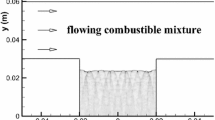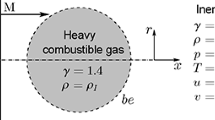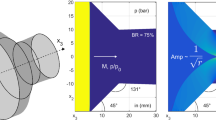Abstract
Direct initiation of one-dimensional Chapman–Jouguet detonations in a framework of reactive Riemann problems has been numerically studied with a detailed chemical reaction mechanism in a stoichiometric hydrogen/oxygen mixture diluted by 70% argon. The reactive Riemann problem, with reactants of high temperature and high pressure to the left of the diaphragm as an energy source with a finite length scale, is applied to initiate detonations downstream. Based on the length scales and initial thermodynamic parameters of the energy source, three different regimes of detonation initiation were found, namely supercritical, critical, and subcritical regimes, which is in accord with the classical blast initiation. The initiation process is essentially an inert shock tube problem nonlinearly coupled with a constant-volume explosion. When the auto-ignition delay time of the constant-volume explosion is large as compared to that behind the leading shock, the mechanism can be identified as an incident shock initiation because the explosion far behind the leading shock cannot affect it. This is essentially the same as the experiments of detonation initiation in a shock tube. Conversely, when the auto-ignition delay time of the constant-volume explosion is small as compared to that behind the leading shock, the initiation process is highly influenced by the heat release of chemical reaction occurring near the rear boundary. A pressure pulse is generated at the tail of the modified expansion fan because of localized maximum reaction rate and eventually evolves into a shock to interact with the leading shock to enhance it. The subsequent detonation downstream is also a result of the initiation of the enhanced leading shock. The numerical results also suggest that the critical energy scaled by the product of the initial pressure and the length scale of the energy source keeps constant with the change in length scale, but can be highly influenced by the initial temperature of the energy source. The scaled critical energy is found to be approximately between 1 and 2 for a wide temperature range above the auto-ignition temperature.






























Similar content being viewed by others
References
Lee, J.H.S., Moen, I.O.: The mechans of transition from deflagration to detonation in vapor cloud explosions. Prog. Energy Combust. Sci. 6, 359–389 (1980). https://doi.org/10.1016/0360-1285(80)90011-8
Chambers, J., Ahmed, K.: Turbulent flame augmentation using a fluidic jet for deflagration-to-detonation. Fuel 199, 616–626 (2017). https://doi.org/10.1016/j.fuel.2017.03.023
Wang, C., Dong, X., Cao, J., Ning, J.: Experimental investigation of flame acceleration and deflagration-to-detonation transition characteristics using coal gas and air mixture. Combust. Sci. Technol. 187, 1805–1820 (2015). https://doi.org/10.1080/00102202.2015.1059332
Wang, C., Zhao, Y., Zhang, B.: Numerical simulation of flame acceleration and deflagration-to-detonation transition of ethylene in channels. J. Loss Prev. Process Ind. 43, 120–126 (2016). https://doi.org/10.1016/j.jlp.2016.05.008
Shepherd, J.E., Lee, J.H.S.: On the transition from deflagration to detonation. In: Hussaini, M.Y., Kumar, A., Voigt, R.G. (eds.) Major Research Topics in Combustion, pp. 439–487. Springer, Berlin (1992). https://doi.org/10.1007/978-1-4612-2884-4_22
Sichel, M.: Transition to detonation: role of explosion within an explosion. In: Hussaini, M.Y., Kumar, A., Voigt, R.G. (eds.) Major Research Topics in Combustion, pp. 491–524. Springer, Berlin (1992). https://doi.org/10.1007/978-1-4612-2884-4_24
Zhang, B., Kamenskihs, V., Ng, H.D., Lee, J.H.S.: Direct blast initiation of spherical gaseous detonations in highly argon diluted mixtures. Proc. Combust. Inst. 33, 2265–2271 (2011). https://doi.org/10.1016/j.proci.2010.06.165
Qi, C., Chen Z.: Numerical simulation of direct detonation initiation in H\(_2\)/O\(_2\)/Ar mixtures with detailed chemistry. 25th ICDERS, Leeds, UK (2015)
Zhang, B., Ng, H.D., Lee, J.H.S.: The critical tube diameter and critical energy for direct initiation of detonation in C\(_2\)H\(_2\)/N\(_2\)O/Ar mixtures. Combust. Flame 159, 2944–2953 (2012). https://doi.org/10.1016/j.combustflame.2012.06.010
Zhang, B., Mehrjoo, N., Ng, H.D., Lee, J.H.S., Bai, C.: On the dynamic detonation parameters in acetylene-oxygen mixtures with varying amount of argon dilution. Combust. Flame 161, 1390–1397 (2014). https://doi.org/10.1016/j.combustflame.2013.11.016
Zhang, B., Liu, H., Yan, B.: Effect of acoustically absorbing wall tubes on the near-limit detonation propagation behaviors in a methane-oxygen mixture. Fuel 236, 975–983 (2019). https://doi.org/10.1016/j.fuel.2018.09.083
Zhang, B., Liu, H., Yan, B.: Investigation on the detonation propagation limit criterion for methane-oxygen mixtures in tubes with different scales. Fuel 239, 617–622 (2019). https://doi.org/10.1016/j.fuel.2018.11.062
Zeldovich, Y.B., Kogarko, S.M., Simonov, N.N.: An experimental investigation of spherical detonation of gases. Sov. Phys. Tech. Phys. 1, 1689–1713 (1956)
Lee, J.H.S., Higgins, A.J.: Comments on criteria for direct initiation of detonation. Philos. Trans. R. Soc. A Math. Phys. Eng. Sci. 357, 3503–3521 (1999). https://doi.org/10.1098/rsta.1999.0506
Lee, J.H.S.: The Detonation Phenomenon. Cambridge University Press, New York (2008)
Lee, J.H.S.: Dynamic parameters of gaseous detonations. Annu. Rev. Fluid Mech. 16, 311–336 (1984). https://doi.org/10.1146/annurev.fl.16.010184.001523
Vasil’ev, A.A.: Dynamic parameters of detonation. In: Zhang, F. (ed.) Shock Waves Science and Technology Library. Detonation Dynamics, vol. 6, pp. 213–279. Springer, Berlin (2012). https://doi.org/10.1007/978-3-642-22967-1_4
He, L., Clavin, P.: On the direct initiation of gaseous detonations by an energy source. J. Fluid Mech. 277, 227–248 (1994). https://doi.org/10.1017/S0022112094002740
Eckett, C.A., Quirk, J.J., Shepherd, J.E.: The role of unsteadiness in direct initiation of gaseous detonations. J. Fluid Mech. 421, 147–183 (2000). https://doi.org/10.1017/s0022112000001555
Mazaheri, K.: Mechanism of the onset of detonation in blast initiation. Ph.D. thesis, McGill University (1997)
Ng, H.D., Lee, J.H.S.: Direct initiation of detonation with a multi-step reaction scheme. J. Fluid Mech. 476, 179–211 (2003). https://doi.org/10.1017/S0022112002002872
Im, K., Yu, S.T.: Analyses of direct detonation initiation with realistic finite-rate chemistry. 41st AIAA Aerospace Sciences Meeting and Exhibit, American Institute of Aeronautics and Astronautics, Reno, NV (2003). https://doi.org/10.2514/6.2003-1318
Wang, B., Yu, S.T.: Direct calculation of spherical detonation initiation of a H\(_2\)/O\(_2\)/Ar mixture by the CESE method. 42nd AIAA Aerospace Sciences Meeting and Exhibit, Reno, NV (2004). https://doi.org/10.2514/6.2004-793
Qi, C., Chen, Z.: Effects of temperature perturbation on direct detonation initiation. Proc. Combust. Inst. 36, 2743–2751 (2017). https://doi.org/10.1016/j.proci.2016.06.093
Berets, D.J., Greene, E.F., Kistiakowsky, G.B.: Gaseous detonations. II. Initiation by shock \({\rm Waves}^{1}\). J. Am. Chem. Soc. 72, 1086–1091 (1950). https://doi.org/10.1021/ja01159a009
Strehlow, R.A., Cohen, A.: Initiation of detonation. Phys. Fluids 5, 97 (1962). https://doi.org/10.1063/1.1706497
Dyner, H.B., Strehlow, R.A.: One-dimensional detonation initiation. AIAA J. 1, 591–595 (1963). https://doi.org/10.2514/3.1600
Gilbert, R.B., Strehlow, R.A.: Theory of detonation initiation behind reflected shock waves. AIAA J. 4, 1777–1783 (1966). https://doi.org/10.2514/3.3777
Oran, E.S., Young, T.R., Boris, J.P., Cohen, A.: Weak and strong ignition. I. Numerical simulations of shock tube experiments. Combust. Flame 48, 135–148 (1982). https://doi.org/10.1016/0010-2180(82)90123-7
Oran, E.S., Boris, J.P.: Weak and strong ignition. II. Sensitivity of the hydrogen oxygen system. Combust. Flame 48, 149–161 (1982). https://doi.org/10.1016/0010-2180(82)90124-9
Smirnov, N.N., Panfilov, I.I.: Deflagration to detonation transition in combustible gas mixtures. Combust. Flame 101, 91–100 (1995). https://doi.org/10.1016/0010-2180(94)00190-4
Smirnov, N.N., Panfilov, I.I., Tyurnikov, M.V., Berdyuguin, A.G., Dushin, V.R., Presnyakov, Yu.P.: Theoretical and experimental investigation of combustion to detonation transition in chemically active gas mixtures in closed vessels. J. Hazard. Mater. 53, 195–211 (1997). https://doi.org/10.1016/S0304-3894(96)01801-8
Short, M., Dold, J.W.: Unsteady gasdynamic evolution of an induction domain between a contact surface and a shock wave. I: thermal runaway. SIAM J. Appl. Math. 56, 1295–1316 (1996). https://doi.org/10.1137/S0036139994276306
Parkins, C.J.: Shock-generated ignition. Newtonian asymptotics for the induction domain between a contact surface and shock. SIAM J. Appl. Math. 61, 701–729 (2000). https://doi.org/10.1137/s0036139997331562
Sharpe, G.J., Short, M.: Ignition of thermally sensitive explosives between a contact surface and a shock. Phys. Fluids 19, 126102 (2007). https://doi.org/10.1063/1.2821909
Melguizo-Gavilanes, J., Rezaeyan, N., Lopez-Aoyagi, M., Bauwens, L.: Simulation of shock-initiated ignition. Shock Waves 20, 467–478 (2010). https://doi.org/10.1007/s00193-010-0255-1
Melguizo-Gavilanes, J., Bauwens, L.: Shock initiated ignition for hydrogen mixtures of different concentrations. Int. J. Hydrog. Energy 38, 8061–8067 (2013). https://doi.org/10.1016/j.ijhydene.2013.03.018
Mooradian, A.J., Gordon, W.E.: Gaseous detonation. I. Initiation of detonation. J. Chem. Phys. 19, 1166–1172 (1951). https://doi.org/10.1063/1.1748497
Gordon, W.E., Mooradian, A.J., Harper, S.A.: Limit and spin effects in hydrogen–oxygen detonations. Symposium (International) on Combustion, vol. 7, pp. 752–759 (1958). https://doi.org/10.1016/S0082-0784(58)80116-2
Clarke, J.F., Kassoy, D.R., Riley, N.: On the Direct Initiation of a Plane Detonation Wave. Proc. R. Soc. Lond. A 408, 129–148 (1986). https://doi.org/10.1098/rspa.1986.0113
Sileem, A., Kassoy, D.R., Hayashi, A.K.: Thermally initiated detonation through deflagration to detonation transition. Proc. R. Soc. Lond. A 435, 459–482 (1991). https://doi.org/10.1098/rspa.1991.0156
Kassoy, D.R., Kuehn, J.A., Nabity, M.W., Clarke, J.F.: Detonation initiation on the microsecond time scale: DDTs. Combust. Theory Model. 12, 1009–1047 (2008). https://doi.org/10.1080/13647830802045080
Zeldovich, Y.B.: Regime classification of an exothermic reaction with nonuniform initial conditions. Combust. Flame 39, 211–214 (1980). https://doi.org/10.1016/0010-2180(80)90017-6
Kapila, A.K., Schwendeman, D.W., Quirk, J.J., Hawa, T.: Mechanisms of detonation formation due to a temperature gradient. Combust. Theor. Model. 6, 553–594 (2002). https://doi.org/10.1088/1364-7830/6/4/302
Gu, X.J., Emerson, D.R., Bradley, D.: Modes of reaction front propagation from hot spots. Combust. Flame 133, 63–74 (2003). https://doi.org/10.1016/S0010-2180(02)00541-2
Liberman, M., Kiverin, A., Ivanov, M.: On detonation initiation by a temperature gradient for a detailed chemical reaction models. Phys. Lett. A 375, 1803–1808 (2011). https://doi.org/10.1016/j.physleta.2011.03.026
Liberman, M.A., Kiverin, A.D., Ivanov, M.F.: Regimes of chemical reaction waves initiated by nonuniform initial conditions for detailed chemical reaction models. Phys. Rev. E 85, 056312 (2012). https://doi.org/10.1103/PhysRevE.85.056312
Ihme, M., Sun, Y., Deiterding, R.: detailed simulations of shock-bifurcation and ignition of an argon-diluted hydrogen/oxygen mixture in a shock Tube. 51st AIAA Aerospace Sciences Meeting including the New Horizons Forum and Aerospace Exposition, Grapevine, TX (2013). https://doi.org/10.2514/6.2013-538
Ihme, M., Sun, Y., Deiterding, R.: Detailed simulations of weak-to-strong ignition of a \(\text{H}_{{2}}\)/\(\text{ O}_{{2}}\)/Ar mixture in shock-tubes. In: Bonazza, R., Ranjan, D. (eds.) 29th International Symposium on Shock Waves 1, pp. 209–214. Springer, Cham (2015). https://doi.org/10.1007/978-3-319-16835-7_31
Gray, J.A.T., Lemke, M., Reiss, J., Paschereit, C.O., Sesterhenn, J., Moeck, J.P.: A compact shock-focusing geometry for detonation initiation: experiments and adjoint-based variational data assimilation. Combust. Flame 183, 144–156 (2017). https://doi.org/10.1016/j.combustflame.2017.03.014
Westbrook, C.K.: Chemical kinetics of hydrocarbon oxidation in gaseous detonations. Combust. Flame 46, 191–210 (1981). https://doi.org/10.1016/0010-2180(82)90015-3
Deiterding, R.: Parallel adaptive simulation of multi-dimensional detonation structures. Ph.D. thesis, Brandenburgischen Technischen Universität Cottbus (2003)
Berger, M.J., Colella, P.: Local adaptive mesh refinement for shock hydrodynamics. J. Comput. Phys. 82, 64–84 (1989). https://doi.org/10.1016/0021-9991(89)90035-1
Deiterding, R.: Detonation structure simulation with AMROC. In: Yang, L.T., Rana, O.F., Di Martino, B., Dongarra, J. (eds.) High Performance Computing and Communications, pp. 916–927. Springer, Berlin (2005). https://doi.org/10.1007/11557654_103
Deiterding, R.: A parallel adaptive method for simulating shock-induced combustion with detailed chemical kinetics in complex domains. Comput. Struct. 87, 769–783 (2009). https://doi.org/10.1016/j.compstruc.2008.11.007
Deiterding, R.: High-resolution numerical simulation and analysis of mach reflection structures in detonation waves in low-pressure H\(_2\)–O\(_2\)2\(_2\)–Ar mixtures: a summary of results obtained with the adaptive mesh refinement framework AMROC. J. Combust. 2011, 298–305 (2011). https://doi.org/10.1155/2011/738969
Ralf, D.: Block-structured adaptive mesh refinement: theory, implementation and application. ESAIM Proc. 34, 97–150 (2011). https://doi.org/10.1051/proc/201134002
Deiterding, R., Bader, G.: High-resolution simulation of detonations with detailed chemistry. In: Warnecke, G. (ed.) Analysis and Numerics for Conservation Laws, pp. 69–91. Springer, Berlin (2005). https://doi.org/10.1007/3-540-27907-5_4
Smirnov, N.N., Betelin, V.B., Nikitin, V.F., Stamov, L.I., Altoukhov, D.I.: Accumulation of errors in numerical simulations of chemically reacting gas dynamics. Acta Astronaut. 117, 338–355 (2015). https://doi.org/10.1016/j.actaastro.2015.08.013
Smirnov, N.N., Betelin, V.B., Shagaliev, R.M., Nikitin, V.F., Belyakov, I.M., Deryuguin, Yu.N., Aksenov, S.V., Korchazhkin, D.A.: Hydrogen fuel rocket engines simulation using LOGOS code. Int. J. Hydrog. Energy 39, 10748–10756 (2014). https://doi.org/10.1016/j.ijhydene.2014.04.150
Singh, G., Clarke, J.F.: Transient phenomena in the initiation of a mechanically driven plane detonation. Proc. R. Soc. Lond. A 438, 23–46 (1992). https://doi.org/10.1098/rspa.1992.0091
Lee, J.H.S.: Initiation of gaseous detonation. Annu. Rev. Phys. Chem. 28, 75–104 (1977)
Radulescu, M.I., Higgins, A.J., Lee, J.H.S., Murray, S.B.: On the explosion length invariance in direct initiation of detonation. Proc. Combust. Inst. 28, 637–644 (2000). https://doi.org/10.1016/S0082-0784(00)80264-7
Li, J., Mi, X., Higgins, A.J.: Effect of spatial heterogeneity on near-limit propagation of a pressure-dependent detonation. Proc. Combust. Inst. 35, 2025–2032 (2015). https://doi.org/10.1016/j.proci.2014.06.039
Acknowledgements
This work was funded by the National Natural Science Foundation of China (No. 12072036), Project of State Key Laboratory of Explosion Science and Technology (QNKT19-01), and Beijing Institute of Technology Innovation Program (2021CX02002). We appreciate helpful discussions with John H.S. Lee at McGill University.
Author information
Authors and Affiliations
Corresponding author
Additional information
Communicated by N. Smirnov.
Publisher's Note
Springer Nature remains neutral with regard to jurisdictional claims in published maps and institutional affiliations.
Rights and permissions
About this article
Cite this article
Ning, J., Chen, D., Hao, L. et al. Numerical study of direct initiation for one-dimensional Chapman–Jouguet detonations by reactive Riemann problems. Shock Waves 32, 25–53 (2022). https://doi.org/10.1007/s00193-021-01056-0
Received:
Revised:
Accepted:
Published:
Issue Date:
DOI: https://doi.org/10.1007/s00193-021-01056-0




